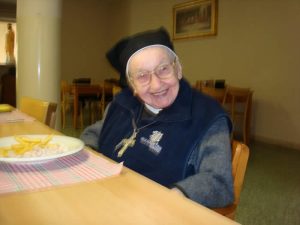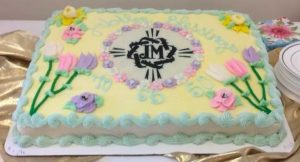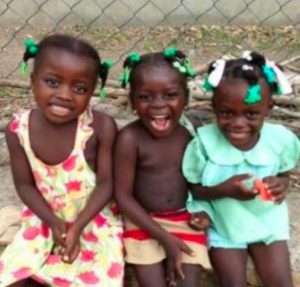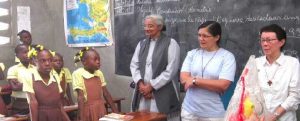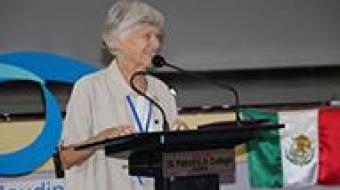
CLOSING REFLECTION FOR BICENTENARY CELEBRATIONS, RJM
October 10, 2017: AGRA, INDIA – Janice Farnham, RJM [USA Province]
At the end of these wondrous days of celebration, when we have heard and seen so much, as our senses have been bombarded with the sights, sounds, scents, tastes, and FEEL of India’s complex gifts, let me begin by inviting us all to take a few moments of silence with this question: “What is it from this time together I want to hold and carry back with me”? [Time of silence]
Before I begin my reflection, I want to recall with a grateful heart the invitation so many of you have extended to me over the years – tertians especially, with whom I was privileged to teach and learn in Rome. “Come to India,” you said. How I longed to make this “dream journey,” which in God’s good time has come to pass. For this, I give thanks to the Lord, to our first Agra missionary mothers, and to Sr. Monica and our General Council for making it all possible. I carry in my heart an experience of India and this conference as a vital link between our Congregation’s past and its future. I have seen and heard that Claudine’s charism is ALIVE and well here, in each one of you, and in all that has been shared this week.
I also want to remind us of the historic nature of this conference. For the first time in the long life of the Religious of Jesus and Mary, we have had an international meeting outside of Europe. I hope that as Agra in 1842 brought a new beginning to the Congregation struggling in its early years, this Agra meeting in 2017 will mark a turning point for what is to come in the future. This week has revealed our desire that the grace that fired our beginnings will continue to well up within us all and give us the courage to move boldly into that future as Claudine and our foremothers did.
“What we have seen and heard, tasted and touched,” the First Letter of John tells us, “we want to share with you, that your joy may be complete” [1Jn.1]. There has been an abundant outpouring of words, images, feelings to share as we rediscovered the mission story of our regions and provinces, as we remembered our graced history with wonder. In these “last words” I was asked to offer, Monica suggested that I “gather the fragments” of our experience and invite us to journey in hope towards the future. As a framework for my reflection, then, I offer the wonderful words of Pope Francis in his letter to Consecrated Persons [2015]: “look to the past with gratitude, live the present with passion, embrace the future with hope.”
Looking to the Past with Gratitude
The week began with Sr. Junkal’s conference, linking our expression of “mission” in the past with what we have come to understand in the light of Vatican II. Her presentation gave us a contemporary theological expression of “mission” as an essential element of Christian life, of apostolic religious life. It reminded us that our call to discipleship is primarily God’s mission, initiated by God and fulfilled in the unfolding of salvation history. She pointed out to us that our past understanding of “mission” has evolved from a physical movement toward foreign lands and cultures in the name of Christ’s church, “ad gentes,” to a sense that each Christian is SENT in the name of Jesus, the Beloved One sent by the Father to reveal the Good News of God’s love to all and for all. In a real sense, “mission” refers to WHO we ARE rather than WHAT we DO. In the past, “going to the missions,” meant leaving behind home, family and all that was familiar to foreign lands and cultures where the task was to convert or Christianize those on the margins of salvation: pagans, non-Christians, unbelievers. Today, we understand being sent in a much larger sense and realize the “peripheries” may be within our own cultures, close to home, even within our own communities. Junkal’s presentation invited us to consider anew what it means to be missioned, to be sent, and to question what new calls, what deep changes, may be challenging us to leave behind the safety of our comfort zones and journey to new margins for our own time, other “foreign lands.”
We looked to our missionary past with gratitude as we focused on our varied foundations and beginnings on five continents and heard again the stories of heroic women facing the challenges of the unknown, of their journeys into unfamiliar lands, peoples and cultures. The missionary pilgrimages of our founding sisters were diverse, yet they revealed the same faith, zeal, creativity, tenacity, persistence and patience in the face of great risks. Above all, those women never wavered in their conviction that God was with them as they faced, like the Apostle Paul, tribulations of every kind. No matter where they were sent, the dangers and obstacles they encountered were much the same: illness, new languages and cultural differences, isolation, suspicion or rejection. Sometimes on their arrival, the residences they were promised were not ready, or not really there! Death was a dark reality that struck regularly, at times in violent ways. But as one sister said, “They never gave up, and never gave in.” They prayed, they stayed and they gave all they had to carry Claudine’s dream to “the least, the most forsaken, the most miserable” of God’s people. And here we are, the living fruit of their faithful response!
Here are some common elements that unfolded for me as we watched and listened to the RJM mission as it unfolded:
- The call of the POOR in every form as a primary focus of our foremothers;
- The need for EDUCATION in faith and/or in academic skills, especially for girls at risk;
- Persistence and PATIENT ENDURANCE through every trial and problem: the examples of India [long journey, illnesses and deaths of so many young sisters]; Canada [all their baggage lost at sea, threats to their own lives]; Ireland [rejection by bishops, house not ready at their arrival];
- Need for HELP FROM OTHERS: clergy, other religious congregations, laity, indigenous women; their interdependence with others to accomplish the work;
- Successful, if slow, GROWTH – after times of trial and setbacks.
Truly, the story of each province, each foundation shows that what was begun in poverty, weakness, deprivation and exile revealed a remarkable strength of purpose and trust in the good God. These women learned the truth of Paul’s missionary claim: “I can do all things in him who strengthens me” [Phil. 4:13]. Like Mary, they believed that nothing was impossible for God!
Living the Present with Passion
Especially in our group sharing, we saw how much passion and commitment these stories called forth from us, as we questioned ourselves on our present ways of living out the mission entrusted to us. We felt admiration and wonder at what God was able to do in and through these pioneers of our provinces. And we also asked questions that surfaced as we considered the situations in which we find our Congregation here and now. I will point out just three major concerns that appeared in the reports we heard from the groups:
- Vocations and vocation promotion:
In the light of our present reality – aging sisters and a diminishing number of candidates – how can we keep Claudine’s charism alive? How can we help it to grow in new, untried ways? - Need for ongoing discernment and apostolic freedom:
This calls for the grace to take a hard look at where we are, at our settled, successful and comfortable ways, so we can “let go” and move to new areas of need, to those margins and peripheries where the Lord may be calling. What in us, in our structures, needs to change for this to happen? In our different situations, what choices are before us? What do we need to help us grow in freedom and flexibility? - Need for others to share the mission with us:
Just as we have learned from our missionary stories of the interdependence that was essential at the origins of each province, so now we need to be creative in engaging others to be our partners in mission for a global community: lay faculties and leaders, indigenous persons, the Family of Jesus and Mary, international volunteers and so many others. How can we extend and multiply our apostolic service, those gifts passed on to us as a legacy? We cannot afford today to be independent laborers in the vineyard. Jesus shared his mission with his friends and apostles; so must we “go and do likewise.” It helps to recall that Claudine never did any of her charitable work alone. One early account tells that “when she was out with some of her friends” and came upon those whose misery called forth her compassion, together they discerned how they could alleviate the greatest of misfortunes: to live and die without knowing a good God. The seeds of the Pious Association were sown in companionship that became a community of friends. The familiar preamble to their Rule states: “When one goes alone on a long and difficult journey, one finds only ordinary and commonplace means of encouragement. But when several journey together, they are filled with confidence, fresh courage, and mutual support.” In 1821, once the congregation was underway at Fourvière, Father Coindre suggested that new bonds of union be formed between the association and the sisters at the Angelique. The associates would help sustain the providence by sponsoring children or assisting in other ways, and they would share in the prayers and good work of the community. Meetings from then on were held at Fourvière, allowing both groups to secure their shared mission to the children they served: a community of friends in Jesus and Mary. As the foundation of our sisters in Spain reminds us: Juntos Mejor! Better together! How are we called today to enlarge our circles of mission and deepen our bonds of union with others?
Embracing the Future with Hope
We have come together to begin celebrating 200 years of life and apostolic service as Religious of Jesus and Mary. While this is indeed cause for grateful joy, it also reminds us that the congregation is no longer young, vibrant with newness. Sociologists have discovered that the ordinary life-span of a religious congregation like ours is about 200 years. Unless an individual or a group is inspired to recapture the original fire of the foundation and the dream of its founders, the institute slowly dies. This year, then, marks a turning point for our congregation, our provinces, every one of our communities and sisters. I said earlier that the Agra conference is a historic moment, but it is also a critical moment. This time in our shared history calls us to reclaim the courage and faith of Claudine as she faced an unknown future. I asked one of you yesterday what you thought was the future of the Congregation and your answer was, “I really don’t know.” Sisters, we don’t know what the future holds for us, any more than Claudine and her companions did, or those missionaries who ventured into our lands years ago. Their challenge was to trust in the good God who led them, to embrace the future with prophetic hope as did Abraham and Sarah, Mary and Elizabeth, Simeon and Anna, God’s poor ones, who “hoped against hope” and believed that the promises of God would be fulfilled. Prophetic hope, in the words of Sr. Constance Fitzgerald, OCD, requires “embarking on a pilgrimage toward the coming of the impossible.” This is a hope rooted in darkness. It calls us to surrender our false hopes and “yield unconditionally to God’s future. It is a hope that exists without the signature of our life and works.” It hollows out in our hearts a place for God’s future, the coming of the impossible. “Nothing is impossible for God.” This was the hope of Claudine, of our foremothers, and it can be ours as well.
The familiar passage attributed to Blessed Oscar Romero reminds us that our share in God’s mission is to plant seeds, knowing that they hold future promise. “We may never see the end results, but that is the difference between the master builder and the worker. We are workers, not master builders; ministers, not messiahs. We are prophets of a future not our own.” And that is a wonderful thing!
I was asked to give “last words,” but we need to remember that each one of us, and all of our sisters at home, are the true “last words” of Claudine. She did not leave us with many of her words or writings. What Claudine left is US, you and me, and all those who have gone before us and will come after us. Whatever our future, I invite us to imagine her message to us as we bring this conference to a close. Perhaps we can hear her saying something like this as we join her on this bicentenary journey to a new recognition of our call to prophetic hope like hers:
- Learn of me as I learned from life, from the Lord, from the Cross, from my brothers and from the poor. Are you looking to know my heart, to see with my eyes, to share my experience of God and the miseries of my time? Do you want to live and serve in this 21st century with my apostolic vision and style? Learn as I did.
- Learn to pray from your weakness, and God’s power will shine through that weakness.
- Let go of falsehood and false hope. Choose the company and friendship of Jesus and Mary in the least, the most deprived, the most forsaken.
- Forgive one another as Christ has forgiven you. Take his yoke and burden upon you, the light yoke and sweet burden of living and dying for others.
- Be friends, be sisters, be mothers . . . walk together in union and joy.
- Don’t be afraid to love this world deeply and treasure all of creation; and when the time comes, to let it go.
- Find your first and last law in the Hearts of Jesus and Mary, in the good news of the Gospel, in the maternal goodness of God, in the Spirit who guided our beginnings and wells up within it a life that is ever renewed [Const. 12].
You are not sure about your future. Neither was I. Move into your future and mine, with hope and trust, because it IS God’s future, and trust that God is faithful, God is good, God will provide.
Janice Farnham, RJM
Agra Conference, CJM Agra
10 October, 2017

